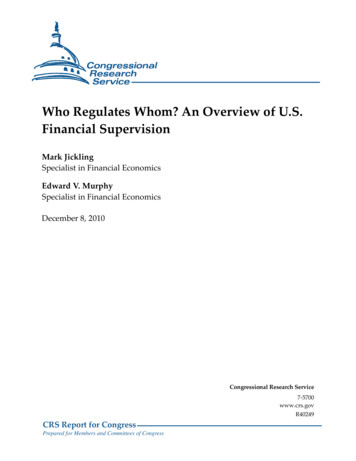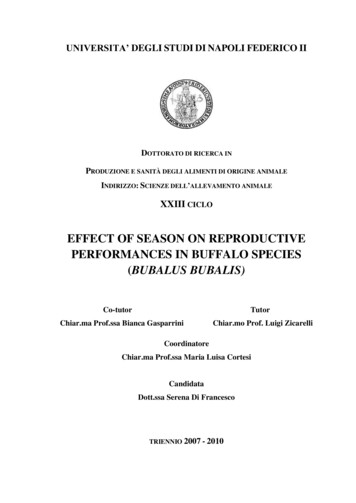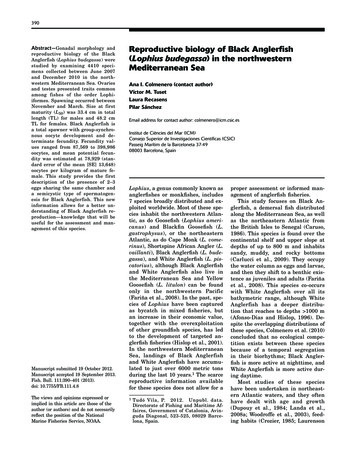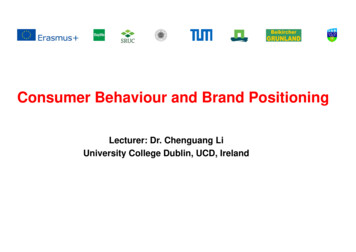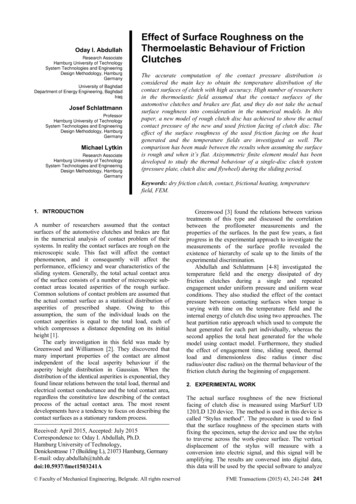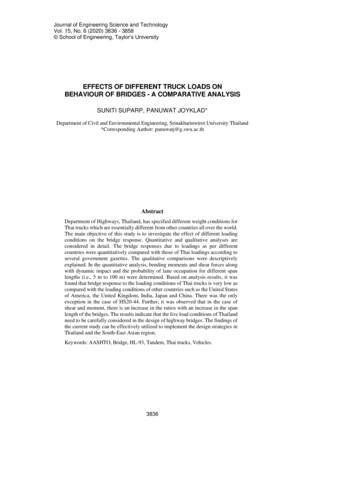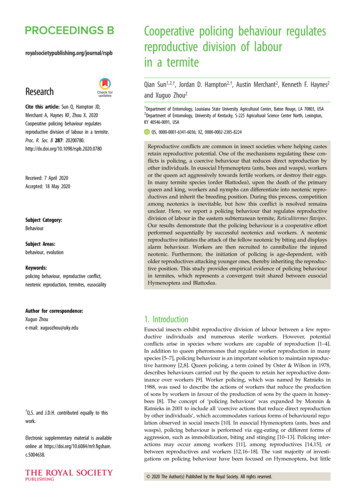
Transcription
e this article: Sun Q, Hampton JD,Merchant A, Haynes KF, Zhou X. 2020Cooperative policing behaviour regulatesreproductive division of labour in a termite.Proc. R. Soc. B 287: eceived: 7 April 2020Accepted: 18 May 2020Subject Category:BehaviourSubject Areas:behaviour, evolutionKeywords:policing behaviour, reproductive conflict,neotenic reproduction, termites, eusocialityAuthor for correspondence:Xuguo Zhoue-mail: xuguozhou@uky.edu†Q.S. and J.D.H. contributed equally to thiswork.Electronic supplementary material is availableonline at erative policing behaviour regulatesreproductive division of labourin a termiteQian Sun1,2,†, Jordan D. Hampton2,†, Austin Merchant2, Kenneth F. Haynes2and Xuguo Zhou21Department of Entomology, Louisiana State University Agricultural Center, Baton Rouge, LA 70803, USADepartment of Entomology, University of Kentucky, S-225 Agricultural Science Center North, Lexington,KY 40546-0091, USA2QS, 0000-0001-6341-6036; XZ, 0000-0002-2385-8224Reproductive conflicts are common in insect societies where helping castesretain reproductive potential. One of the mechanisms regulating these conflicts is policing, a coercive behaviour that reduces direct reproduction byother individuals. In eusocial Hymenoptera (ants, bees and wasps), workersor the queen act aggressively towards fertile workers, or destroy their eggs.In many termite species (order Blattodea), upon the death of the primaryqueen and king, workers and nymphs can differentiate into neotenic reproductives and inherit the breeding position. During this process, competitionamong neotenics is inevitable, but how this conflict is resolved remainsunclear. Here, we report a policing behaviour that regulates reproductivedivision of labour in the eastern subterranean termite, Reticulitermes flavipes.Our results demonstrate that the policing behaviour is a cooperative effortperformed sequentially by successful neotenics and workers. A neotenicreproductive initiates the attack of the fellow neotenic by biting and displaysalarm behaviour. Workers are then recruited to cannibalize the injuredneotenic. Furthermore, the initiation of policing is age-dependent, witholder reproductives attacking younger ones, thereby inheriting the reproductive position. This study provides empirical evidence of policing behaviourin termites, which represents a convergent trait shared between eusocialHymenoptera and Blattodea.1. IntroductionEusocial insects exhibit reproductive division of labour between a few reproductive individuals and numerous sterile workers. However, potentialconflicts arise in species where workers are capable of reproduction [1–4].In addition to queen pheromones that regulate worker reproduction in manyspecies [5–7], policing behaviour is an important solution to maintain reproductive harmony [2,8]. Queen policing, a term coined by Oster & Wilson in 1978,describes behaviours carried out by the queen to retain her reproductive dominance over workers [9]. Worker policing, which was named by Ratnieks in1988, was used to describe the actions of workers that reduce the productionof sons by workers in favour of the production of sons by the queen in honeybees [8]. The concept of ‘policing behaviour’ was expanded by Monnin &Ratnieks in 2001 to include all ‘coercive actions that reduce direct reproductionby other individuals’, which accommodates various forms of behavioural regulation observed in social insects [10]. In eusocial Hymenoptera (ants, bees andwasps), policing behaviour is performed via egg-eating or different forms ofaggression, such as immobilization, biting and stinging [10–13]. Policing interactions may occur among workers [11], among reproductives [14,15], orbetween reproductives and workers [12,16–18]. The vast majority of investigations on policing behaviour have been focused on Hymenoptera, but little 2020 The Author(s) Published by the Royal Society. All rights reserved.
(a) Insect collection and maintenanceField and laboratory colonies of R. flavipes were used in this study.Field colonies were collected from the Red River Gorgearea, Daniel Boone National Forest (Slade, KY, USA) and theUniversity of Kentucky Arboretum (Lexington, KY, USA). Thesecolonies were obtained in summer using trapping stations filled(b) Orphaning assay to test ergatoid number restrictionThis assay was used to simulate the reproductive replacementprocess after the death of primary reproductives. Groups of100 workers were kept in Petri dishes (35 mm diameter) withmoistened paper towel placed at the bottom. Two treatments(‘removal’ and ‘non-removal’ of ergatoids) were conducted. Thisexperiment was specifically designed in a way to compare thenumber of ergatoids that can potentially differentiate and survive(removal) with that actually survived (non-removal). All termiteswere maintained at 27 1 C and in complete darkness for 90 days.Each dish was checked by identifying the sex and counting thenumber of newly differentiated ergatoids. Each ergatoid wasremoved and replaced with a worker in the ‘removal’ treatment,but returned to the dish in the ‘non-removal’ treatment. Dishes in‘removal’ treatments were checked every day, while dishes in ‘nonremoval’ treatments were checked every 10 days to reduce stressto reproductives resulting from manipulations needed for sexidentification. The number of remaining termites in each groupwas counted every 30 days, and mortality was calculated based onthe difference between the numbers of initial and remaining individuals. Injured ergatoids were not counted. A total of 20 replicationswere made with five replications in each of the four colonies. Twofield and two laboratory colonies were used in this experiment.(c) Orphaning assay for observation of policingbehaviourThis assay was designed to observe policing behaviour underorphaning conditions, which resembled the ‘non-removal’ treatment above. The dishes were incubated at 27 1 C for a total of90 days. Once a week, the dishes were checked for dryness, andwater was added if the paper towels at the bottom appeared tobe dry. Between 60 and 90 days, each dish was checked for thepresence of ergatoids, and the dishes with ergatoids were selectedto be video recorded for 6 days. Video cameras (Canon Vixia HFG20, Canon Inc., Tokyo, Japan) were used for recording andyielded high-quality images. The dishes and cameras wereshaded under a piece of cardboard (1.5 m 0.8 m) during recording. Ergatoids were identified as male or female and colourmarked using enamel paint (Testor Corporation, Rockford, IL,USA) on their head capsule prior to recording. The colour codesfor ergatoids were randomized, and we did not find influence ofthe colour mark on the termites or their subsequent behaviour.In addition, subterranean termites (with the exception of alates)do not develop functional eyes to recognize colour. During recording, the dishes were checked every day for missing ergatoids(which were cannibalized), and newly formed ergatoids werecolour marked. When a marked ergatoid was missing, the videoof the previous 24 h was quantitatively analysed.We define the ‘victim’ as the ergatoid that was eventually cannibalized, the ‘attacker’ as the individual who attacked the victim,and ‘bystanders’ as the ergatoids who did not perform the firstmajor attack. A major attack was recognized when the attacker visibly injured the victim such that the researcher could see theabdomen was torn, haemolymph was leaking and the victim2Proc. R. Soc. B 287: 202007802. Material and methodswith dampened cardboard rolls. Once captured termites wereextracted from traps, and they were placed in Petri dishes(14.5 cm 2.0 cm) with moistened unbleached paper towel astheir only food source for 7–10 days before they were used in experiments. Only workers and soldiers were collected from thefield. Laboratory colonies were established in 2010 by pairs ofsibling alates from a dispersal flight in Lexington, Kentucky, andwere kept in closed plastic boxes filled with moistened woodmulch and pinewood blocks in the laboratory for 5 yearsbefore use. All colonies were maintained in complete darkness(L : D 0 : 24), at 27 1 C, 80–99% RH.royalsocietypublishing.org/journal/rspbis known about its occurrence or nature in termites (orderBlattodea), a group of eusocial insects that evolved 50 Myrearlier than eusocial Hymenoptera [19].Policing behaviour serves two functions that are notmutually exclusive, which are regulating genetic conflictsand improving colony efficiency [8,20,21]. Genetic conflictsarise between colony members due to relatedness asymmetries. For example, in social Hymenoptera with haplodiploidsex-determination, workers are often capable of laying unfertilized male eggs, and they are more closely related to their ownsons than males produced by other individuals [2,8,22]. Moreover, policing behaviour contributes to colony efficiency evenwhen little or no genetic conflict is present, as it optimizesthe allocation of colony resources to reproduction [8,23], ormaintains an adaptive colony-level phenotype [24].Unlike social Hymenoptera, termite colonies are usuallyfounded and dominated by a pair of primary reproductives(queen and king). Upon their death, neotenic reproductivesof both sexes can differentiate either from workers, whichbecome ergatoid reproductives that lack wing buds, or fromnymphs, which become nymphoid reproductives that possessshort wing buds [25]. Reproductive succession by neotenicshas been reported in at least 13.4% of ‘higher’ termite genera(Termitidae) and 61.7% of ‘lower’ termite genera (all othertermite families) [26]. In termites with diplodiploid sexdetermination, individuals are more closely related to theirown offspring than that of their siblings, regardless of outbreeding or inbreeding. Therefore, genetic conflicts potentially existand competition for reproduction between nest-mates isexpected [27]. Moreover, given the fact that workers are reproductively totipotent in many species, colony-level efficiencycan be compromised if excess neotenics differentiate, as itresults in a reduced labour force and increased resourcedemand by the reproductives and their brood.In the presence of fertile reproductives, neotenic formationis regulated through pheromones [6,28,29], and policingbehaviour through overt aggression was considered rare intermites [28,30]. However, during the process of reproductivesuccession when colonies are orphaned and inhibitorypheromones are temporarily absent, production of excessiveneotenic reproductives in the colony is expected [6,28,29].In addition, cannibalism of neotenics was observed in severaltermite families including Termopsidae [31], Kalotermitidae[30,32–34] and Rhinotermitidae [35,36], suggesting thepresence of policing behaviour that directly regulates reproduction in termites. Empirical studies of the process and causes ofpolicing behaviour, however, are lacking. In this study, we conducted a series of experiments to understand whether thenumber of ergatoid neotenics is regulated behaviourallyduring reproductive succession, and how policing behaviouris performed in the eastern subterranean termite, Reticulitermesflavipes. Furthermore, we investigated a proximate factor thatdetermines the succession of reproductives.
female163male***14***no. ergatoids12***10***8n.s.64405060assay time (day)70******n.s.n.s.2n.s.00102030405060assay time (day)70809001020308090Figure 1. Restriction of ergatoid numbers in orphaning assay. Female and male ergatoids that formed from groups of 100 workers were documented for 90 dayspost establishment of the experiment. Cumulative number of differentiated ergatoids (removal treatment) and surviving number of ergatoids (non-removal treatment) are presented (mean s.e.) and compared within the same observation day. n.s., not significant; ***, p 0.001; GLMM, Poisson family; n 20 pertreatment per observation day. (Online version in colour.)quickly fled. The first major attack was designated as time ‘0’, andthe frequency of vibration and number of workers surrounding thevictim were documented. A 1 min sample (30 s before and afterthe time point) was analysed for all these behaviours, with samplesselected 5, 15, 20, 25, 30, 45 and 60 min before and after time ‘0’.Worker density near the victim was an indicator of cannibalism.The density was quantified by counting the number of workersand soldiers within a 4 mm radius from the centre of the victim(the radius approximately equals the body length of a worker).Only field-collected colonies were used in this experiment.(d) Policing assay to test the effect of ergatoid ageThis assay was used to determine if policing behaviour in R. flavipesis associated with the age of ergatoids. Each group of 50 workerswas kept in a petri dish (55 mm diameter) lined with six layers ofmoistened paper towel. A pair of virgin ergatoids, one femaleand one male, was added to each dish on day 1. Female andmale treatments were conducted, with a younger female or maleergatoid being added to the initial group every day. When addedto the dish, the initial pair of ergatoids was 7 days post differentiation (7 days old) and became older over the course of theexperiment, and subsequent ergatoids were no more than 7 daysold. All of the ergatoids were colour marked as previouslydescribed, and no new ergatoids differentiated during this assay.The dishes were recorded until one of the ergatoids was missing.The video was then analysed to identify who attacked that ergatoid.In each replication, the workers, initial ergatoids and introducedergatoids originated from the same colony. A total of 9 and 10 replications were made for female and male treatments, respectively;aggressively interacting pairs that were the same sex were analysedfor their age differences. This experiment did not attempt toaddress sex-specificity, but it was designed for increased chanceof sex-specific aggression, and only same-sex aggressions wereanalysed to eliminate confounding factors associated with sex.Only field-collected colonies were used in this experiment.(e) Statistical analysesData were analysed using R (https://www.r-project.org) andStatistix 10 (Analytical Software, Tallahassee, FL, USA), andgraphs were generated using SigmaPlot 13 (Systat Software Inc,Chicago, IL, USA). Data for ergatoid number and mortality inreproductive ‘removal’ and ‘non-removal’ assays were fitted toPoisson family generalized linear mixed models using R’s glmerfunction. In the model for ergatoid number, ergatoid sex andtreatment group (removal versus non-removal) were coded asfixed effects, while colony of origin was coded as a randomeffect. An observation-level random effect was introduced toavoid overdispersion. In the model for mortality, treatmentgroup was coded as a fixed effect, while colony of origin wascoded as a random effect. In both cases, data were analysed separately for each 10-day interval. Data testing the influence of ergatoidage on aggressive interactions in the policing assay were analysedin Statistix using a Wilcoxon signed-rank test.3. Results(a) The number of ergatoids is restrictedIn ‘removal’ treatment, significantly more female and maleergatoids differentiated than remained in ‘non-removal’ treatment within 90 days (figure 1; χ 2 137.14, d.f. 1, p 0.001;GLMM, Poisson family; n 20). At the end of day 90, 11.80 2.59 (mean s.e.) female and 4.75 1.06 male ergatoids differentiated when they were removed daily, compared with only2.60 0.34 female and 1.05 0.05 male ergatoids if they werenot removed. In addition, there was significantly higher overallmortality in ‘non-removal’ than in ‘removal’ treatments (electronic supplementary material, figure S1; χ 2 30.36, d.f. 1,p 0.001; GLMM, Poisson family; n 20). In ‘non-removal’groups, we frequently observed injured ergatoids partially consumed by workers, along with other intact ergatoids. Betweenthe two treatments, the mortality difference (8.6 individuals atday 60 and 10.2 at day 90) closely matched the difference in thenumber of ergatoids that differentiated and that survived (6.2at day 60 and 12.9 at day 90), suggesting cannibalism of ergatoids in ‘non-removal’ treatments was primarily responsiblefor the difference in mortality.(b) Ergatoids and workers cooperate in elimination ofexcessive ergatoidsA total of seven events were captured of the full behaviouralprocess, which started with one ergatoid attacking anotherergatoid and ended with the injured individual beingProc. R. Soc. B 287: spbremovalnon-removal
d )(b)(f)Proc. R. Soc. B 287: 20200780(g)victimattacker bystandersworkersoliderergatoidFigure 2. Behavioural process of cooperative policing. (a) An ergatoid attacker holds the victim using mouthparts (time 10 s). (b) The attacker performs a majorattack by biting the victim on its abdomen (time 0). (c) The major attack causes the victim to quickly flee (time 0). (d ) The attacker displays alarm behaviour byvigorously vibrating its body towards multiple directions (time 1 min). (e) Bystanders also display alarm behaviour in the same manner (time 5 min).( f ) Workers then surround and nibble the victim (time 30 min). (g) Victim is partially cannibalized (time 2 h). Attacker: ergatoid who performed the firstmajor attack. Victim: ergatoid who received the attack and was later cannibalized. Bystander: other ergatoids. (Online version in colour.)cannibalized by workers (figure 2; electronic supplementarymaterial, table S1, movies S1–S4; movies S1–S4 were clipsobtained from the same replication showing a representativebehavioural response). In this behaviour, the attacker antennated the victim first, and used mouthparts to hold theabdomen or thorax of the victim before biting. The bitealways caused the victim to leak haemolymph and quicklyflee. Right after the attack, the attacker displayed alarmbehaviour by vigorously vibrating the body in multiple directions; interestingly, the ergatoids who did not participate inthe aggression (i.e. bystanders) also performed alarm behaviour after the attack, while the victim rarely engaged invibration (figure 3a). Workers, on average, displayed littlevibration (figure 3a). With the alarm of ergatoids, workersrapidly began to surround the injured victim, biting and consuming it while it was still alive, and the cannibalism reacheda peak 30 min after the attack (figure 3b). As the cannibalismbegan to decline following consumption of the victim, the frequency of vibration by the ergatoid attacker and bystandersbegan to reduce (45–60 min after the attack) (figure 3a).Soldiers were produced via differentiation from workers inall seven replications by the time of policing behaviour (electronic supplementary material, table S1), but they did notparticipate in alarm behaviour or cannibalism (figure 3a,b).(c) Ergatoid elimination is age-dependentThe majority of aggressive interactions involved an ergatoidattacking a same-sex ergatoid (15 out of 19), while the othersinvolved either a male ergatoid attacking a female (one casein the female treatment), or a group of workers nibbling andconsuming an ergatoid (1 and 2 cases in female and male treatments, respectively). In the same-sex aggressive interactions,the attacker was always older than the victim in both femaleand male treatments (figure 4; female: Z 2.3664, p 0.01,n 7; male: Z 2.5205, p 0.01, n 8; Wilcoxon signed-ranktest, one-tailed). The median age difference between the pairof attacker and victim was 5 and 2 days for females andmales, respectively.4. Discussion(a) Cooperative effort and justification of‘policing behaviour’Overall, this study reveals a behavioural mechanism regulatingreproductive division of labour during reprodu
In many termite species (order Blattodea), upon the death of the primary queen and king, workers and nymphs can differentiate into neotenic repro-ductives and inherit the breeding position. During this process, competition among neotenics is inevi
